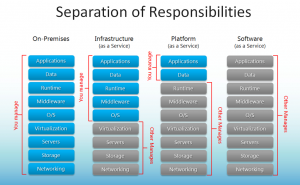
10 Trends Driving IT Infrastructure Towards Hybrid Cloud Computing
What's the future of your network infrastructure? It might be time to move towards hybrid cloud computing. Read the 10 trends that are driving the switch!
First, let’s start off with the provocative prediction by Gartner:
“By 2020, a corporate “no-cloud” policy will be as rare as a “no-internet” policy is today.“
That’s a pretty strong statement — one that should give pause for tech professionals at companies where the IT infrastructure relies entirely on on-premises enterprise data centers at the exclusion of external cloud services.
So let’s unpack this prediction by looking at the top IT infrastructure trends that will drive most of the non-cloud holdouts toward hybrid cloud computing.
1. Enterprise Software Vendors are Aggressively Pushing Customers Toward Cloud Solutions
First up, is a marked shift by the major ERP software vendors towards a “cloud-first” development strategy.
As evidence of this trend, Microsoft recently announced a major restructuring (with thousands of layoffs) that are intended to help its Azure cloud services offering catch up with the industry’s breakaway leader, Amazon’s AWS.
The bottom line? The newest features and most exciting capabilities will appear first on cloud architecture solutions. This means that traditional “meat and potatoes” ERP and CRM packages running on local, on-premises enterprise data centers are at risk of falling into a legacy software death spiral — as vendors nudge enterprises toward more “modern” cloud solutions.
2. Rapid Uptake of IaaS and PaaS Changes the Enterprise Applications Landscape
Gartner expects that revenue from Infrastructure as Service (IaaS) and Platform as a Service (PaaS) will grow to more than $55 billion by 2020, a figure that may exceed the revenue from hardware server sales.
This rapid adoption underscores the philosophical change brought about by cloud computing. We’re evolving from a software-centric mindset (where IT teams were responsible for all aspects of deployment, from hardware to software) to a new, multi-provider world where companies access computing infrastructure (IaaS) or fully-tested software stacks (PaaS) to run their data on a “power by the hour” basis.
3. Younger Generation of IT Talent Views Cloud Solutions as the New Normal
Just as younger workers who were born digital (sometimes referred to as digital natives), the youngest generation of IT developers that got their start (often by building websites) have grown up on a steady diet of hacking open source software solutions (such as the popular LAMP stack: Linux, Apache, MySQL and PHP) together with cloud-based storage solutions from DropBox or Amazon’s popular AWS (Amazon Web services).
In a world where companies are doing whatever they can to attract tech-savvy young professionals living in hip urban areas, companies need to keep in mind that IT job candidates will likely elect to work on modern cloud services implementations, adding additional pressure on companies to adopt cloud solutions.
4. Companies with On-Premises IT Infrastructure Will Opt for Hybrid Cloud Computing Over Pure Cloud Solutions Due to Continuity of Business (COB) and Vendor Control Issues
Do you remember the old saying “Don’t outsource what you can do yourself?”
The meaning of this traditional piece of sage business advice is that once you lose the expertise to understand what the consultants or vendors are doing, you will ultimately lose control of your business process “know how” — leaving you vulnerable to outside factors beyond your control.
This mindset (which is perfectly valid!) is likely one of the main reasons that quite a few companies have yet to adopt any form of cloud technology: they fear they will be relinquishing too much control to outside vendors (and leaving them beholden to vendors who will be difficult to swap out for a different vendor.)
This feeling of “lack of control” is further exacerbated by concerns about COB (continuity of business) when the unthinkable happens — the internet goes down, perhaps for a long, long time.
Given these scenarios, it’s not surprising that Gartner predicts companies with “legacy” on-premises IT infrastructures will choose hybrid cloud computing as their first “baby” step into cloud solutions.
(Even internet giants like Facebook are moving some of their operations off the public cloud by building their own internal, private cloud infrastructure. Read more about how IBM lost the Facebook’s WhatsApp cloud business here.)
As we’ll see next, cloud vendors like Amazon AWS are happy to make the transition to hybrid cloud computing as smooth as possible.
5. Major Cloud Services Vendors Make Transition to Hybrid Cloud Computing Relatively Painless
Given the control and business continuity concerns that businesses have about making a transition to cloud services (see the previous item), vendors like Amazon AWS are going out of their way to make it easy to extend existing on-premises IT infrastructure with hybrid cloud computing capabilities.
For example, Amazon has developed a comprehensive set of tools to help IT departments incorporate many of the benefits of cloud computing by providing software that allows existing tools, such as LDAP directory services or on-premises SAP implementations, to access cloud-based storage seamlessly.
As a result, it’s much easier to make the transition to hybrid cloud computing. (Implementing pure cloud solutions, in contrast, remains a much bigger step, which usually involves re-architecting the software applications themselves.)
6. Today’s Users Have Higher Expectations for Accessing ERP/Big Data Remotely from Mobile Devices
So far we’ve looked at the trends driving companies toward cloud computing from the technology implementation side of things.
That’s only part of the picture.
Read more ... https://formaspace.com/articles/tech-lab/hybrid-cloud-computing-trends/?utm_source=linkedin&utm_source=einpresswire&utm_medium=social&utm_medium=content+&utm_campaign=artcile-071817&utm_campaign=article-071817
Brooke Turner
Formaspace
8002511505
email us here
Extending Your IT Infrastructure to the AWS Cloud
EIN Presswire does not exercise editorial control over third-party content provided, uploaded, published, or distributed by users of EIN Presswire. We are a distributor, not a publisher, of 3rd party content. Such content may contain the views, opinions, statements, offers, and other material of the respective users, suppliers, participants, or authors.



